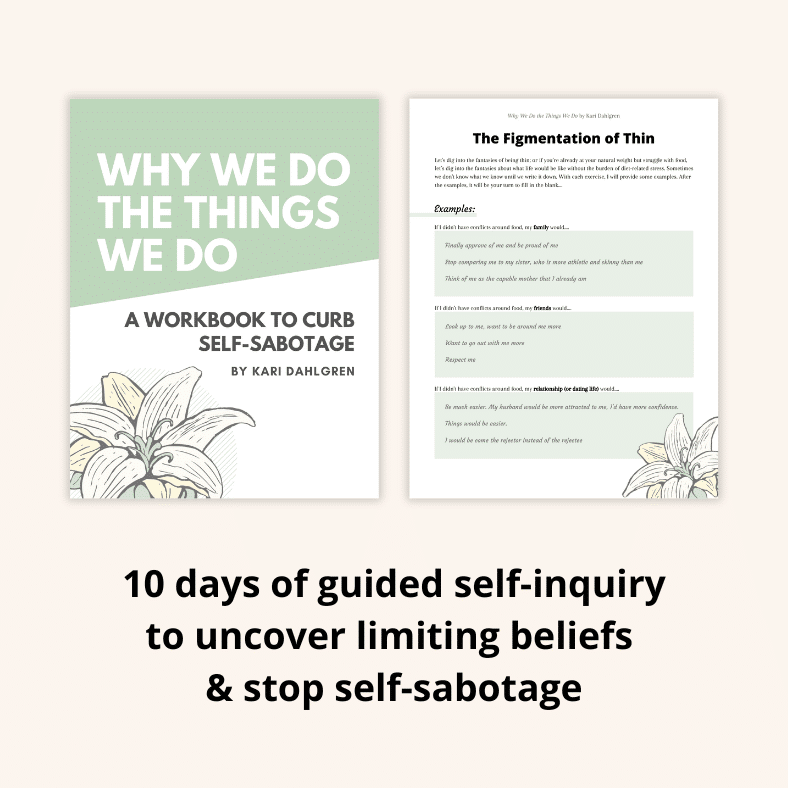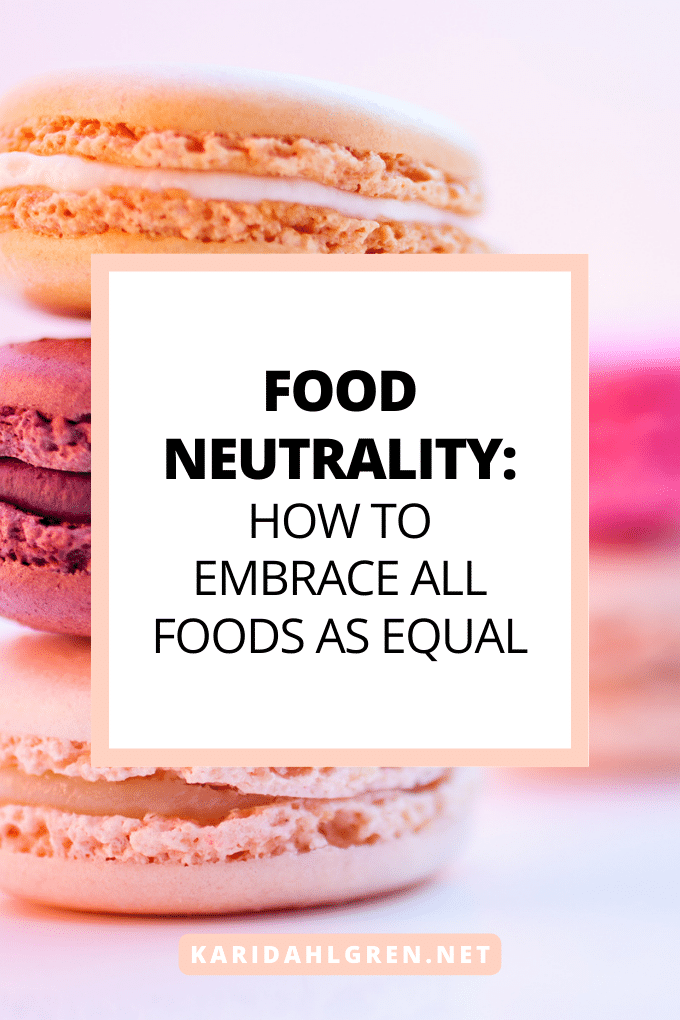
Food neutrality and dieting are opposites. While dieting encourages you to “eat this, not that,” food neutrality invites you to view all foods as equal and eat what appeals to you.
I used to live in the land of Diet Culture — an unhappy participant constantly chasing weight loss unsuccessfully. I tried every trick in the book: keeping sweets completely out of the house, eliminating carbs, eliminating anything processed…
No matter how hard I tried to follow the rules and eat only “good foods,” every attempt at dieting ended in the same thing: binge eating the foods that I spent so much energy restricting — carbs, sugar, and “junk.” I wish I found food neutrality sooner!
The Core Principles of Food Neutrality
Everywhere we turn, there’s advice on what we should or shouldn’t eat. Do you remember the bestselling book Eat This, Not That? It was the bible of “good and bad foods” (or maybe it still is, I don’t pay attention) and it’s a perfect example of how society has been trained to think in terms of food dichotomy.
Viewing foods as “sinful and guilty” or “virtuous and clean” perpetuates an unhealthy relationship with food. Then, the more we restrict “sinful and guilty” foods, the more prone we are to binge on those very foods, often eating more than we would have if all foods were allowed.[1]
Enter food neutrality, a refreshing perspective that flips traditional dieting on its head. At its heart, food neutrality involves eating without judgment. No food is inherently “good” or “bad.” With food neutrality, food is morally neutral and can be enjoyed for what it is.
Here is an example of food neutrality: “Oh, I can’t have any dessert — I have rheumatoid arthritis and sugar makes it worse.” This person isn’t skipping sugar because it’s “bad;” they’re skipping it for wellness.
Another example of food neutrality is: “Oh, I love dessert. Yes please, I’d like a piece of cake.” In this example, there is no guilt for eating foods that society otherwise deems as “bad.” Food is food.
Here is an example of what food neutrality is NOT: “Oh, I can’t have any dessert — sugar is bad for you.” When a person does not have any health conditions worsened by sugar, it’s perfectly fine to eat it when you’re craving it and aren’t already full.
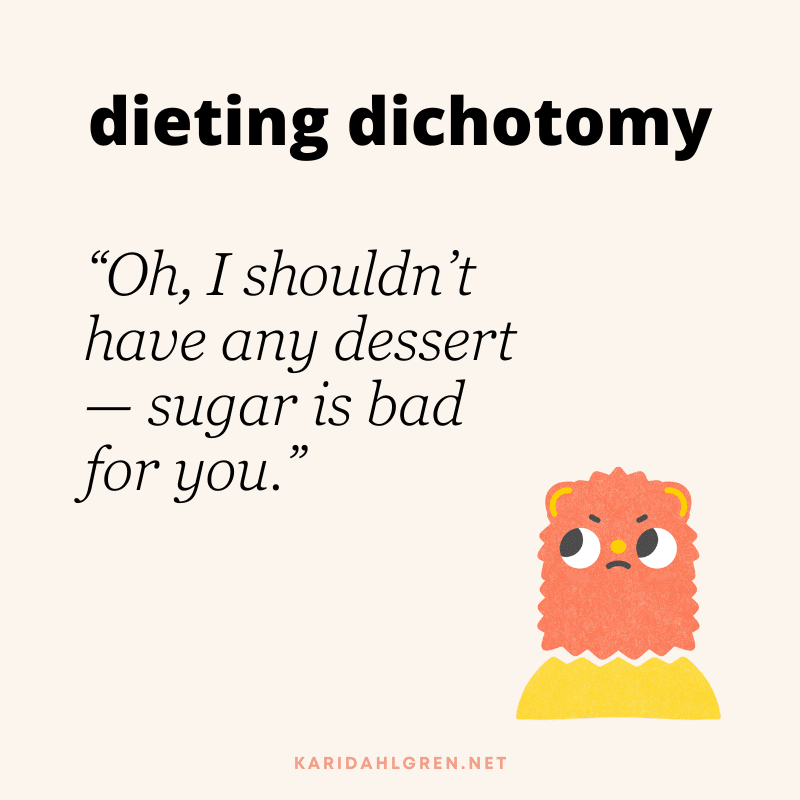
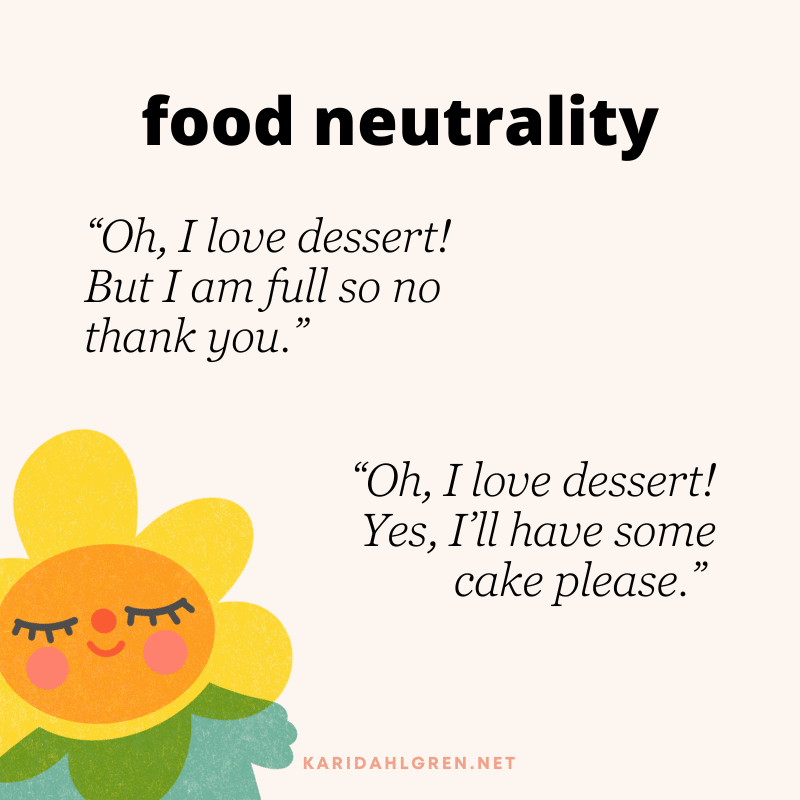
You might wonder, how can we ensure we’re nourishing our bodies effectively with this mindset? That’s where intuitive eating enters the stage. It’s about tuning into your body’s signals and understanding what it needs.
Sometimes you might crave a fresh salad, other times a comforting bowl of pasta. When you’re in a pinch, you might even want fast food. For the average dieter, this is a reason to panic; but with food neutrality, it’s a chance to choose self-kindness.
Food neutrality helps us avoid beating ourselves up for eating foods labeled as “bad,” such as fast food, because it means you’re “lazy.” It’s not always accessible to make every single meal highly nutritious, and when you’re hungry, you need to eat.
Furthermore, food neutrality allows us to remove the stress from our eating choices and get back to enjoying our food, no matter what it is. Best of all, when we eat without extra stress, we digest our food better, and reduced stress can potentially reduce gastrointestinal disorders like acid reflux and irritable bowel syndrome.[2] This can help create even more ease around food.
But, Wouldn’t Food Neutrality Lead to Unhealthy Eating?
For many of us, it can feel scary to view food as a soothing balm for emotional needs. After all, emotional eating is something that we want to avoid, right?
Food neutrality doesn’t mean eating past fullness. It acknowledges that food is a source of joy and, if you’re craving pasta after a hard day, it’s perfectly fine to eat it and allow it to nourish you physically and emotionally.
But what about foods that are labelled as “worse” than pasta? What about sugar — which plenty of clinical evidence has linked to inflammation and disease? How can sugar possibly be a “neutral food?”
When exploring intuitive eating and sugar cravings, it’s important to acknowledge the psychology that plays a role: we want what we can’t have. When sugar is labelled as “bad” and therefore off-limits, we psychologically crave it more. This isn’t just speculation either. Studies have found that making certain foods off-limits increases our preoccupation with them.[3]
Often, sugar cravings are normal, especially when you allow hunger to get too extreme, when you don’t eat enough, or when you’re stressed.[4] Within the world of intuitive eating and food neutrality, it’s important to eat the foods you’re craving, including sugar, when you’re hungry.
If you struggle with eating without hunger, we will address that part with plenty of tips soon. But first, let’s explore more science behind food neutrality so that we can put any lingering apprehensions to rest.
The Power of Food Neutrality: Looking at Clinical Evidence
An esteemed scientific journal — the Journal of the Academy of Nutrition and Dietetics — found that intuitive eating leads to better physical and emotional health compared to dieting.[5] Not only were traditional diet programs found to be ineffective for weight management, but they also brought about psychological distress.
When the lens shifted to intuitive eating and food neutrality, researchers found significant enhancements. Both physical and mental health improved, particularly in the areas of eating habits, lifestyle, body image, self-esteem, and overall quality of life — quite the list!
Other reputable studies have found the same: dieting leads to poorer self-esteem.[6] I’m sure you can relate to this phenomenon — dieting makes you feel crazy and obsessed about food! Fortunately, intuitive eating is linked to improved body image satisfaction.[7]
If you need any more conviction about the positive implications of food neutrality, another study found that intuitive eating weakens the link between weight-related shame and binge eating.[8] In other words, when we aren’t busy beating ourselves up for “falling off the wagon” when we diet, we stop feeling ashamed.
Then we can look at the concept of “Health At Every Size,” or HAES, a movement that emphasizes health and well-being over weight or body size. Another compelling study compared a HAES program to a traditional dieting regimen, and the differences were stark.
In the traditional dieting group, 41% of participants dropped out of the study — a concerning attrition rate. All the while, participants in the HAES program not only maintained a stable weight but also witnessed sustained health improvements over a span of two years.[9]
With intuitive eating and food neutrality, there’s often a looming fear of potential weight gain. I’ve certainly been there, keeping sweets completely out of the house during my dieting days over the fear of binge eating. Hopefully, these studies quell any lingering apprehensions.
Addressing Criticisms and Challenges of Food Neutrality
As with any paradigm shift, the philosophy of food neutrality isn’t without its critics and skeptics. One of the most common criticisms is that food neutrality might inadvertently promote unhealthy eating habits.
Skeptics argue that if all foods are seen as “neutral,” individuals might lean into indulgent choices more often than nutrient-dense ones (a potential sign of entitlement eating). There’s a valid concern that, without some guidance, people might consistently opt for foods low in essential nutrients, potentially compromising their health in the long run.
Fortunately, science backs up food neutrality and intuitive eating as leading to healthier outcomes than dieting. A study published in the Journal of Nutrition Education and Behavior found that the more intuitively a person eats, the more fruits and vegetables they consume.[10]
In other words, viewing all foods as equal did not lead to eating indulgent, less-nutritious foods — it led to eating more nutritious foods than people who diet.
Now that you understand the benefits of food neutrality along with the abundance of clinical evidence that supports it, how can you put it into practice? Let’s dive into some actionable steps, starting with an effective way to address the fear of gaining weight.
How to Practice Food Neutrality If You Struggle with Overeating
Embracing food neutrality can be a daunting endeavor, especially for individuals who grapple with overeating. A common apprehension is the fear of unrestricted indulgence once all foods are perceived as neutral.
Fortunately, my Stop, Drop, & Feel method can be a pivotal tool in managing these concerns. Here’s a brief rundown of how to employ the SDF:
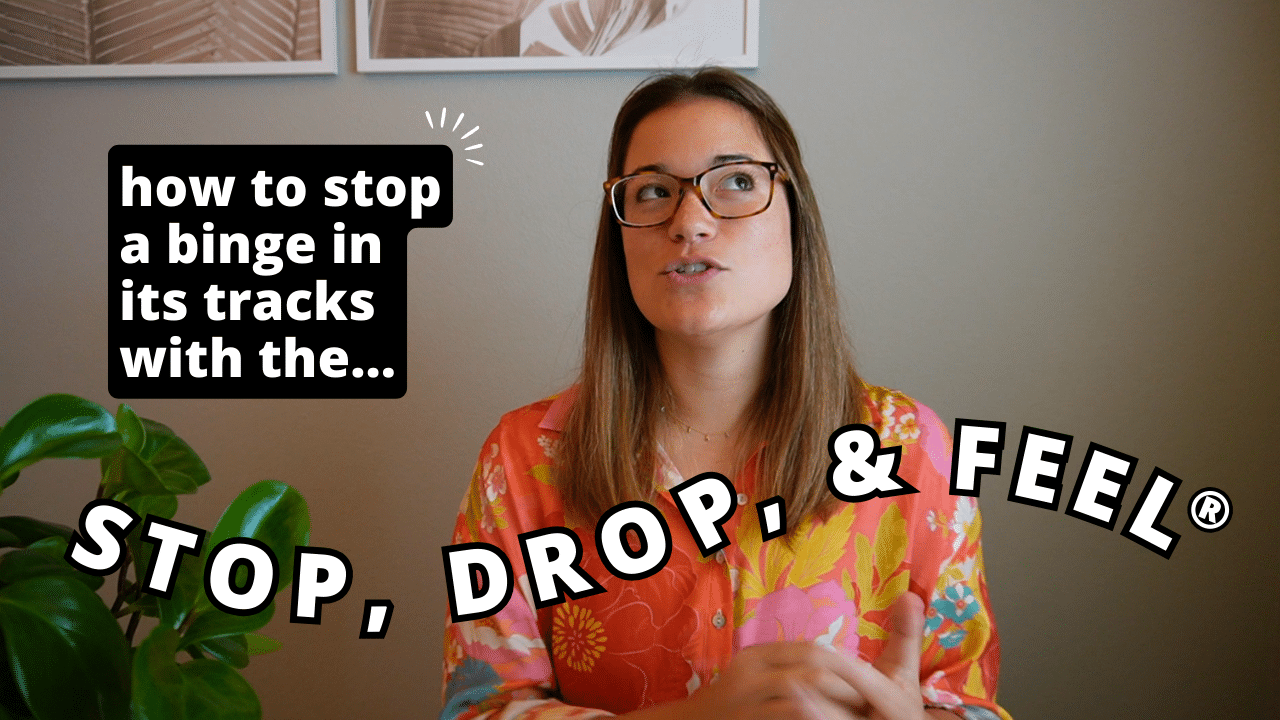
- Stop: As the urge to consume food without hunger hits, pause. Assure yourself that you can still eat the food you’re craving if that’s still what you really want after the SDF is over.
- Drop: If feasible, shift to another room and set a timer for a concise two minutes. This is the moment to drop into your inner self, diving deep into introspection about what you’re feeling in that instant.
- Feel: Get curious about your emotions and allow them space. Let them exist alongside you. For those crucial two minutes, simply be in the moment, experiencing and acknowledging your emotions.
The underlying principle of the Stop, Drop, & Feel is that every time we lean towards food without genuine hunger, there’s an uncomfortable emotion that either hasn’t been acknowledged or is being avoided. The Stop, Drop, & Feel encourages you to sit still with these emotions, thereby building emotional tolerance.
When we can tolerate the discomfort (which could be loneliness, sadness, anxiety, etc.) that drives the desire to eat without hunger, that’s when we can stop overeating patterns; and when that happens, it becomes less scary to embrace food neutrality. Self-trust begins to form.
Keep in mind that the intersection between food neutrality and the Stop, Drop, & Feel lies in granting yourself permission to eat. The pivotal step of permission prevents the Stop, Drop, & Feel from becoming another form of restriction (which would otherwise the restrict-binge cycle).
The Stop, Drop, & Feel is not a means to avoid eating. Instead, it’s designed to foster emotional awareness and tolerance.
Other Steps for Embracing Food Neutrality
Navigating the path towards food neutrality involves more than simply changing one’s eating habits. It’s a holistic approach that calls for challenging deep-seated beliefs, acquiring knowledge, seeking expert guidance, and nurturing a heightened self-awareness.
Here are some pivotal steps to assist you on this transformative journey:
1. Recognizing and Challenging Food Beliefs and Biases
Every one of us has grown up with certain beliefs and biases about food. These beliefs might stem from family habits, cultural backgrounds, or societal influences. A crucial step towards embracing food neutrality is recognizing these biases.
- Self-reflection: Take some time to jot down any beliefs you hold about specific foods. Labeling some as “superfoods” or others as “junk” is common. Reflect on where these beliefs came from and ask yourself if they serve your well-being.
- Challenge these beliefs: Once identified, challenge these biases by asking, “Is this belief based on scientific evidence, or is it a cultural or personal bias?” Often, you’ll find that many of our deeply held beliefs aren’t grounded in science but in societal norms or personal experiences.
2. Educating Yourself on Nutrition Without Moral Judgments
Understanding the nutritional components of food can empower you to make informed choices without leaning into guilt or shame.
- Neutral sources: Dive into books, documentaries, and articles that present food facts without leaning into the “good” or “bad” narrative. Focus on understanding nutrients, their functions, and how different foods can be part of a balanced diet.
- Stay inspired: Subscribe to newsletters that promote a neutral approach towards food. My newsletter is a great resource. You can start by downloading my free ebook The Spiritual Seeker’s Guide to Stop Binge Eating.
3. Seeking Support and Guidance
Food neutrality, especially when paired with intuitive eating, can be a complex journey. Seeking professional guidance can be immensely beneficial.
- Therapists: Emotional eating, past traumas, or deep-seated beliefs about one’s body can hinder the journey towards food neutrality. Therapists, especially those trained in eating disorders or intuitive eating, can provide tools and support.
- Nutritionists: While embracing food neutrality, a nutritionist can guide you on how to balance your meals to ensure you’re receiving all the necessary nutrients, without invoking guilt or judgment on food choices.
- Coaches: While therapists and nutritionists are credentialed professionals, coaches often have personal and real-world experience. For example, I am someone with personal experience climbing out of compulsive eating and I coach others through the same with Feel Normal Around Food™️ Coaching.
4. Cultivating Mindfulness and Self-Awareness Around Eating
Being present during your meals and understanding your body’s signals can revolutionize your relationship with food.
- Mindful eating: This involves truly savoring each bite, paying attention to textures, flavors, and how the food makes you feel. Over time, you’ll be able to discern between emotional hunger and physical hunger, helping you make choices aligned with your body’s needs.
- Journaling: Keeping a food and emotion diary can provide insights into patterns that might be driving certain food choices. Over time, this practice can highlight triggers or emotions that prompt you to reach for specific foods.
Incorporating these steps into your journey towards food neutrality can facilitate a smoother transition, ensuring you’re well-equipped with knowledge, support, and self-awareness. Remember, food neutrality isn’t about perfection but about fostering a kinder, more informed relationship with the foods you choose to consume.
The Goal of Food Neutrality
Food neutrality seeks to liberate us from the chains of diet culture and the incessant judgment that accompanies every bite. The ultimate goal isn’t about weight loss, achieving an “ideal” body, or adhering to stringent food rules. It’s about finding freedom and joy in eating, nurturing our bodies without guilt or shame, and fostering a loving relationship with food and ourselves.
By viewing all foods as equal, you cultivate a more intuitive, mindful, and joyful relationship with eating. The journey might not be without its challenges, but the end result — a life where food is a source of pleasure, not stress — is worth every effort.
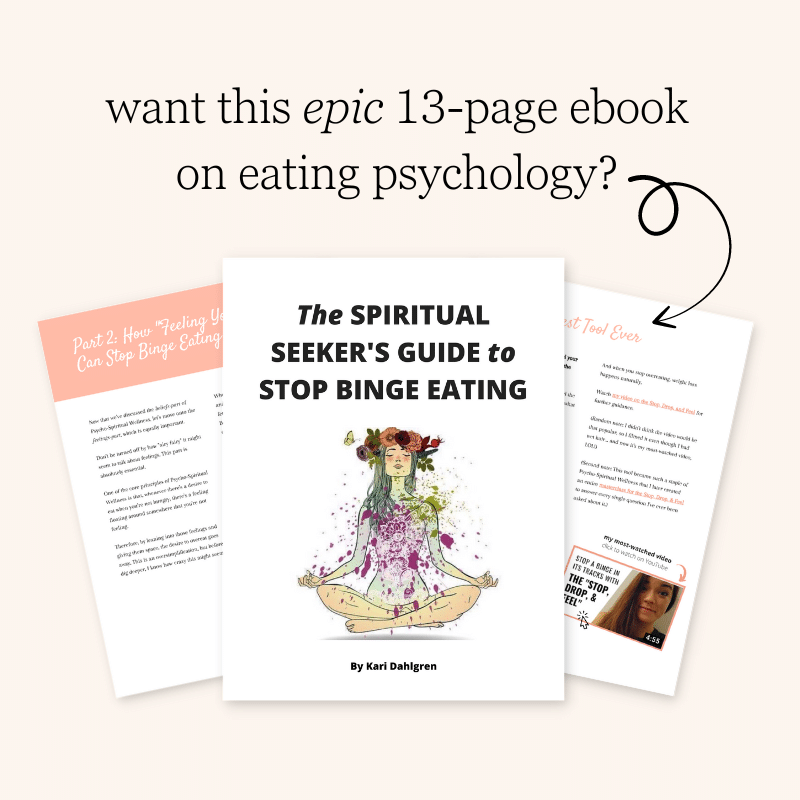
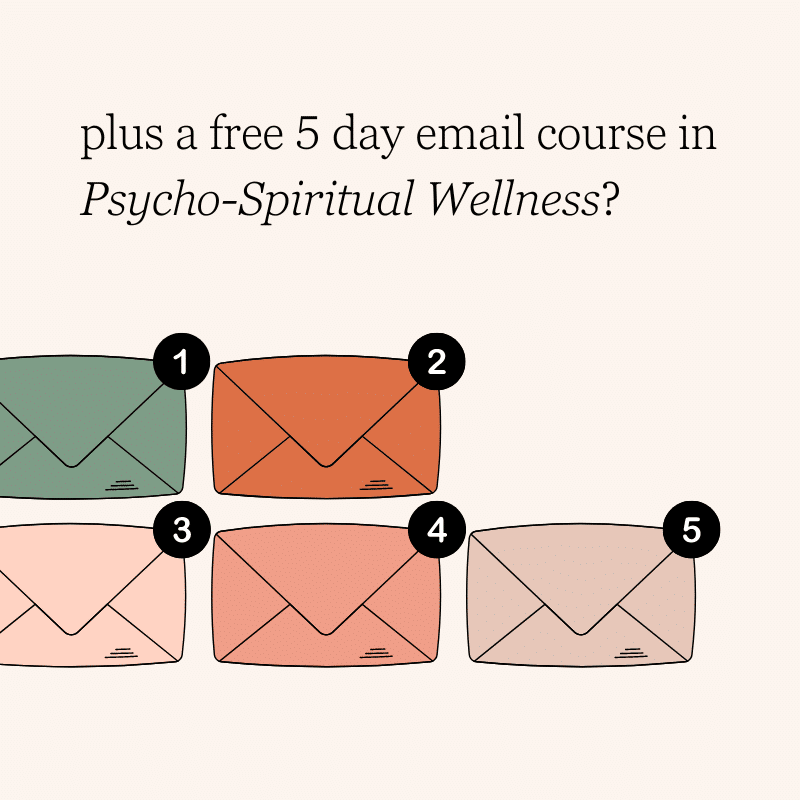
![best seller [cover of Why We Do the Things We Do]](https://karidahlgren-net.b-cdn.net/wp-content/uploads/2023/09/why-we-do-the-things-we-do-1.png)
